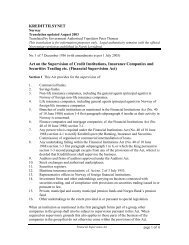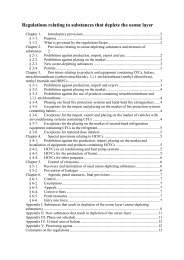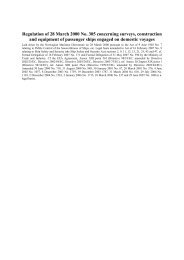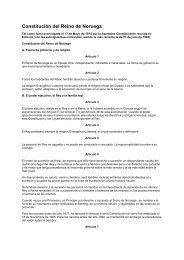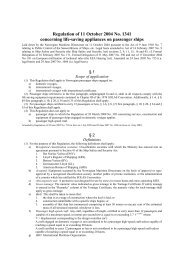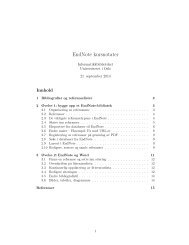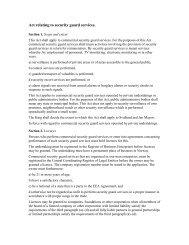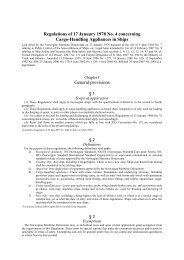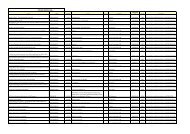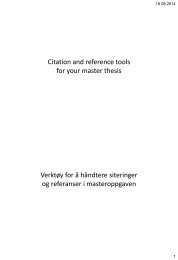Regulation of 17 December 2004 No. 1855 concerning life-saving ...
Regulation of 17 December 2004 No. 1855 concerning life-saving ...
Regulation of 17 December 2004 No. 1855 concerning life-saving ...
Create successful ePaper yourself
Turn your PDF publications into a flip-book with our unique Google optimized e-Paper software.
<strong>Regulation</strong> <strong>of</strong> <strong>17</strong> <strong>December</strong> <strong>2004</strong> <strong>No</strong>. <strong>1855</strong><br />
<strong>concerning</strong> <strong>life</strong>-<strong>saving</strong> appliances on cargo ships<br />
Laid down by the <strong>No</strong>rwegian Maritime Directorate on <strong>17</strong> <strong>December</strong> <strong>2004</strong> pursuant to the Act <strong>of</strong> 9 June 1903 no. 7<br />
relating to Public Control <strong>of</strong> the Seaworthiness <strong>of</strong> Ships, etc. Legal basis amended to Act <strong>of</strong> 16 February 2007 <strong>No</strong>. 9<br />
relating to Ship Safety and Security (the Ship Safety and Security Act) sections 2, 9, 11, 13, 14, 15, 16, 43 and 45, cf.<br />
Formal Delegation <strong>of</strong> 16 February 2007 <strong>No</strong>. <strong>17</strong>1 and Formal Delegation <strong>of</strong> 31 May 2007 <strong>No</strong>. 590 by the Ministry <strong>of</strong><br />
Trade and Industry and Act <strong>of</strong> 26 June 1998 <strong>No</strong>. 47 relating to Recreational and Small Craft section 23, cf. Formal<br />
Delegation <strong>of</strong> 27 <strong>No</strong>vember 1998 <strong>No</strong>. 1095, Formal Delegation <strong>of</strong> 1 <strong>December</strong> 1998 <strong>No</strong>. 4532 and Formal Delegation<br />
<strong>of</strong> 31 May 2007 <strong>No</strong>. 591 by the Ministry <strong>of</strong> Trade and Industry. Amended 4 February 2005 <strong>No</strong>. 111, 15 July 2005 <strong>No</strong>.<br />
828 and 29 June 2007 <strong>No</strong>. 1006 (i.a. legal basis).<br />
§ 1<br />
Scope <strong>of</strong> application<br />
(1) This <strong>Regulation</strong> applies to <strong>No</strong>rwegian cargo ships, with the specifications referred to in the second to fourth<br />
paragraphs.<br />
(2) This <strong>Regulation</strong> applies to all cargo ships and manned lighters irrespective <strong>of</strong> their size, trade area and date <strong>of</strong><br />
construction.<br />
(3) Cargo ships in great coasting or greater trade, as well as cargo ships <strong>of</strong> 500 gross tonnage and above irrespective<br />
<strong>of</strong> their trade area, shall in their entirety comply with the current requirements for <strong>life</strong>-<strong>saving</strong> appliances <strong>of</strong> SOLAS<br />
1974, Chapter III, as subsequently amended. In addition, Section 2 to Section 7, Section 11, Section <strong>17</strong>, Section 26 and<br />
Section 27 <strong>of</strong> this <strong>Regulation</strong> shall apply.<br />
Amended by <strong>Regulation</strong> <strong>of</strong> 29 June 2007 <strong>No</strong>. 1006 (in force on 1 July 2007).<br />
§ 2<br />
Definitions<br />
For the purposes <strong>of</strong> this <strong>Regulation</strong>:<br />
a) Recognized classification society means classification societies with which the Ministry has entered into an<br />
agreement pursuant to Section 41 <strong>of</strong> the Ship Safety and Security Act:<br />
1. Det <strong>No</strong>rske Veritas (DNV);<br />
2. Lloyd's Register <strong>of</strong> Shipping (LRS);<br />
3. Bureau Veritas (BV);<br />
4. Germanischer Lloyd (GL);<br />
5. American Bureau <strong>of</strong> Shipping (ABS).<br />
b) Accepted means equipment accepted by the <strong>No</strong>rwegian Maritime Directorate on the basis <strong>of</strong> approval or typeapproval<br />
by a recognized classification society, another public or private institution, or the administration <strong>of</strong> a<br />
country which has ratified the SOLAS Convention.<br />
c) Manned lighter means a lighter for which the manning has been stipulated in accordance with the regulation<br />
currently in force <strong>concerning</strong> the manning <strong>of</strong> <strong>No</strong>rwegian ships.<br />
d) Gross tonnage means the number entered as gross tonnage in the Tonnage Certificate. If safety tonnage is<br />
entered in the remarks column <strong>of</strong> the Tonnage Certificate, this tonnage shall apply as gross tonnage.<br />
e) Built means:<br />
1. that the ship is at a stage <strong>of</strong> construction where the keel is laid; or<br />
2. that the construction <strong>of</strong> a specific ship can be established as having commenced; or<br />
3. that the parts <strong>of</strong> the ship that have been put together comprise at least 50 tons or constitute 1% <strong>of</strong> the<br />
calculated weight <strong>of</strong> the building material, whichever is less.<br />
f) Float-free launching means the method <strong>of</strong> launching survival craft, where the craft is automatically released<br />
from the sinking ship and is ready for use.<br />
g) Free-fall launching means the method <strong>of</strong> launching survival craft, where the craft with persons and equipment on<br />
board is released and allowed to fall into the sea without any form <strong>of</strong> device that can restrain its fall.<br />
h) IMO means the International Maritime Organisation.<br />
i) Embarkation ladder means a ladder mounted at embarkation stations for survival craft to facilitate safe access to<br />
the survival craft after launching.<br />
j) Length (L) means 96 % <strong>of</strong> the total length on a waterline at 85 % <strong>of</strong> the least moulded depth measured from the<br />
top <strong>of</strong> the keel, or the length from the fore side <strong>of</strong> the stem to the axis <strong>of</strong> the rudder stock on that waterline,<br />
whichever is the greater. In vessels designed with a rake <strong>of</strong> keel, the waterline on which this length is measured<br />
shall be parallel to the designed waterline.
k) LSA Code means the International Life-Saving Appliance Code adopted by the IMO Maritime Safety Committee<br />
by resolution MSC.48(66), as subsequently amended by the IMO.<br />
l) Cargo ship means any ship that is not a passenger ship, fishing vessel, lighter or pleasure craft. For the purposes<br />
<strong>of</strong> this <strong>Regulation</strong>:<br />
1. passenger ship means a ship that can carry more than 12 passengers or which is required to have <strong>of</strong>ficial<br />
permission to carry passengers.<br />
2. Fishing vessel means any vessel used commercially for catching fish, including whales, seals, seaweed and<br />
sea tangle or other living resources <strong>of</strong> the sea.<br />
3. Pleasure craft means any floating device intended for and capable <strong>of</strong> movement on water and not used for<br />
commercial purposes.<br />
4. Lighter means a hull or ship without propulsion machinery which is towed or pushed for all moves, and<br />
which is used for carrying cargo.<br />
m) Rescue boat means a boat that has been designed to save persons in distress and to assist survival craft.<br />
n) Immersion suit means a protective suit that reduces the loss <strong>of</strong> body heat for a person immersed in cold water. It<br />
shall be insulated.<br />
o) Survival craft means <strong>life</strong>boats and <strong>life</strong>rafts.<br />
p) SOLAS Convention means the International Convention <strong>of</strong> 1974 for the Safety <strong>of</strong> Life at Sea, as subsequently<br />
amended by the IMO.<br />
q) Tanker means a cargo ship built or outfitted for the carriage <strong>of</strong> flammable liquid cargo in bulk, including<br />
chemicals, oil and natural gas.<br />
r) Thermal protective equipment means a pouch or suit made <strong>of</strong> waterpro<strong>of</strong> material with a low thermal<br />
conductivity.<br />
s) Launching device or launching arrangement means an appliance that can safely transfer a survival craft or rescue<br />
boat from its mounted position into the water.<br />
§ 3<br />
Duties<br />
The company, master and other persons working on board shall perform their duties in accordance with the Ship<br />
Safety and Security Act and the supplementary provisions laid down in this <strong>Regulation</strong>.<br />
Amended by <strong>Regulation</strong> <strong>of</strong> 29 June 2007 <strong>No</strong>. 1006 (in force on 1 July 2007).<br />
§ 4<br />
Exemptions<br />
The <strong>No</strong>rwegian Maritime Directorate may, in individual cases and upon written application, grant exemption from the<br />
requirements <strong>of</strong> this <strong>Regulation</strong>. There must be special reasons that make the exemption necessary and it must be<br />
justifiable in terms <strong>of</strong> safety. Exemptions can only be granted where they do not contravene international agreements<br />
to which <strong>No</strong>rway has acceded.<br />
§ 5<br />
Documentation<br />
Documentation shall be submitted to the <strong>No</strong>rwegian Maritime Directorate in accordance with the list <strong>of</strong> drawings<br />
currently in force prepared by the <strong>No</strong>rwegian Maritime Directorate.<br />
§ 6<br />
Requirements for the approval <strong>of</strong> equipment, etc.<br />
(1) Equipment that is required pursuant to this <strong>Regulation</strong> and that is covered by the <strong>Regulation</strong> <strong>of</strong> 29 <strong>December</strong><br />
1998 <strong>No</strong>. 1455 <strong>concerning</strong> marine equipment (the Marine Equipment <strong>Regulation</strong>), that is brought on board following<br />
the entry into force <strong>of</strong> this <strong>Regulation</strong>, shall be approved by a <strong>No</strong>tified Body pursuant to the same <strong>Regulation</strong> and shall<br />
be wheel-marked.<br />
(2) Equipment that is not covered by the Marine Equipment <strong>Regulation</strong> shall be accepted.<br />
(3) Previously approved or accepted equipment that was brought on board prior to the entry into force <strong>of</strong> this<br />
<strong>Regulation</strong>, may still be used until the equipment is replaced or the arrangement is changed.<br />
(4) Equipment that is not required pursuant to this <strong>Regulation</strong>, but that is voluntarily installed on board, shall satisfy<br />
the provisions <strong>of</strong> this Section.<br />
(5) The <strong>No</strong>rwegian Maritime Directorate may decide that new equipment shall be installed on board in connection<br />
with major conversions or repairs <strong>of</strong> the ship that will affect <strong>life</strong>-<strong>saving</strong> appliances. The same applies to changes <strong>of</strong> the<br />
operational pattern and manning or extensions <strong>of</strong> the trade area.
(6) If the <strong>No</strong>rwegian Maritime Directorate following a demonstration <strong>of</strong> the arrangement <strong>of</strong> the <strong>life</strong>-<strong>saving</strong><br />
appliances finds that it does not function appropriately, or may endanger the <strong>life</strong> and health <strong>of</strong> those on board in view<br />
<strong>of</strong> the ship’s operation and manning, the <strong>No</strong>rwegian Maritime Directorate may demand that the equipment be replaced<br />
or the arrangement altered.<br />
§ 7<br />
Life-<strong>saving</strong> appliances<br />
Any ship <strong>of</strong> less than 500 gross tonnage shall, depending on trade area and tonnage, carry at least the <strong>life</strong>-<strong>saving</strong><br />
appliances as specified in the table below.<br />
Trade area/tonnage<br />
Equipment<br />
All ships in<br />
trade areas<br />
1 and 2<br />
All ships in<br />
trade area 3 and<br />
greater trade<br />
Manned<br />
lighters<br />
Survival craft 200% 200% 100% § 8<br />
Rescue boat – § 11<br />
Less than 100 gr.t.<br />
More than 100 gr.t.<br />
–<br />
1<br />
Lifebuoys § 14<br />
Less than 300 gr.t.<br />
More than 300 gr.t.<br />
3<br />
5<br />
Lifejackets 150% 150% 150% § 16<br />
Lifejackets for children<br />
For everyone<br />
on board<br />
–<br />
1<br />
3<br />
5<br />
For everyone<br />
on board<br />
3<br />
5<br />
§<br />
– § 16<br />
Immersion suits 100% 100% 100% § <strong>17</strong><br />
Rocket parachute flares 3 6 – § 15<br />
Hand flares 3 6 – § 15<br />
Line-throwing appliance – § 15<br />
Less than 100 gr.t.<br />
More than 100 gr.t.<br />
0<br />
1<br />
1<br />
1
§ 8<br />
Survival craft<br />
(1) With the exception <strong>of</strong> tankers, all ships shall on each side <strong>of</strong> the ship carry at least one survival craft with<br />
sufficient capacity to carry at least the total number <strong>of</strong> persons on board. If only one <strong>life</strong>raft is carried in trade areas 1<br />
and 2, it must be possible to launch it from both sides <strong>of</strong> the ship. In stead <strong>of</strong> a survival craft as mentioned above, a<br />
free-fall <strong>life</strong>boat located at the stern may be carried.<br />
(2) A sufficient number <strong>of</strong> survival craft shall be carried to ensure that the remaining survival craft have the<br />
capacity to carry the total number <strong>of</strong> persons the ship is certified to carry, in the event that one survival craft breaks<br />
down or is rendered useless.<br />
(3) Tankers shall either carry an enclosed <strong>life</strong>boat on both sides <strong>of</strong> the ship or a free-fall <strong>life</strong>boat located at the stern,<br />
with sufficient capacity to carry at least the total number <strong>of</strong> persons on board.<br />
(4) Manned lighters in trade area 3 or greater trade shall be equipped with an inflatable <strong>life</strong>raft with sufficient<br />
capacity to carry everyone on board. Manned lighters in trade areas 1 and 2 shall be equipped with a CE-labelled<br />
motor-powered workboat which at least satisfies the requirements for design category C, or a <strong>life</strong>raft that can carry at<br />
least the total number <strong>of</strong> persons on board. For manned lighters carrying flammable liquid cargo, the <strong>No</strong>rwegian<br />
Maritime Directorate will lay down the requirements in each individual case, depending on the lighter’s manning,<br />
trade area, structure and operational conditions.<br />
§ 9<br />
Hydrostatic release<br />
All <strong>life</strong>rafts shall be fitted with a hydrostatic release and shall be located so as to be able to float freely, cf. Annex 1.<br />
§ 10<br />
Requirements for the stowage <strong>of</strong> survival craft<br />
– the embarkation and launching arrangements<br />
Survival craft shall be stowed pursuant to Annex 1.<br />
§ 11<br />
Rescue boats<br />
(1) Ships built on or after 1 January 2005 <strong>of</strong> 100 gross tonnage and more, shall carry a rescue boat.<br />
(2) Ships <strong>of</strong> less than 100 gross tonnage, irrespective <strong>of</strong> their date <strong>of</strong> construction, do not have to carry a rescue boat<br />
if:<br />
a) the ship is equipped with a CE-labelled motor-powered workboat which at least satisfies design category<br />
C; or<br />
b) the ship has the manoeuvrability under any conditions to get close to a person immersed in the sea, and to<br />
easily recover persons directly from the water.<br />
(3) Ships in small coasting or lesser trade area <strong>of</strong> more than 500 gross tonnage built between 1 July 1986 and 1<br />
January 2005 shall have installed a rescue boat on board upon the first renewal survey at the latest or upon the<br />
intermediate survey after 1 January 2006, whichever comes first.<br />
(4) Ships <strong>of</strong> between 100 and 500 gross tonnage irrespective <strong>of</strong> their trade area shall have a rescue boat installed on<br />
board at the latest upon the initial survey or intermediate survey after 1 January 2006, whichever comes first.<br />
(5) Until the requirement <strong>of</strong> the third and fourth paragraphs has been met, ships that are equipped with rafts only<br />
shall in addition carry a rescue boat.<br />
(6) The requirement for a rescue boat may be met by carrying a <strong>life</strong>boat that complies with the requirements for a<br />
rescue boat.<br />
(7) The rescue boat may be included in the capacity <strong>of</strong> survival craft as mentioned in Section 8 in trade areas 1 and<br />
2.<br />
(8) The rescue boat and the CE-labelled workboat shall be operated by their own launching arrangements which are<br />
capable <strong>of</strong> both launching and embarkation while the ship is making headway.<br />
Amended by <strong>Regulation</strong> <strong>of</strong> 4 February 2005 <strong>No</strong>. 111.
§ 12<br />
Rescue boat embarkation and launching arrangements<br />
(1) The embarkation and launching arrangement for rescue boats shall allow boarding and launching operations to<br />
take place in the shortest possible time. The maximum time spent shall not exceed five minutes.<br />
(2) It shall be possible to board and launch the rescue boat directly from its stowed position with the number <strong>of</strong><br />
persons on board designated as rescue boat crew.<br />
(3) The launching arrangement shall comply with the requirements <strong>of</strong> Annex 1. It shall be possible to launch rescue<br />
boats while the ship is making headway, proceeding at not less than 5 knots.<br />
(4) It shall be possible to embark a rescue boat in no more than five minutes while loaded to capacity with persons<br />
and equipment.<br />
(5) It shall be possible to observe the launching and embarkation operations from the bridge.<br />
§ 13<br />
Muster stations<br />
Launching stations shall comply with the requirements <strong>of</strong> Annex 2.<br />
§ 14<br />
Lifebuoys<br />
(1) At least one <strong>of</strong> the <strong>life</strong>buoys on each side shall be fitted with a buoyant <strong>life</strong>line <strong>of</strong> at least 30 metres <strong>of</strong> length.<br />
(2) At least one <strong>of</strong> the <strong>life</strong>buoys on each side shall be fitted with a self-igniting smoke signal and a self-igniting<br />
light, but without a line. It shall be possible to release them quickly from the bridge.<br />
(3) The other <strong>life</strong>buoys shall be fitted with self-igniting lights, but without lines.<br />
(4) For vessels that shall carry three <strong>life</strong>buoys only, one <strong>of</strong> the <strong>life</strong>buoys shall be fitted with a <strong>life</strong>line <strong>of</strong> at least 30<br />
metres <strong>of</strong> length, and one <strong>life</strong>buoy shall be fitted with a self-igniting smoke signal and a self-igniting light.<br />
(5) In special cases the <strong>No</strong>rwegian Maritime Directorate may impose other requirements for <strong>life</strong>buoys than those<br />
mentioned in the first to fourth paragraphs, depending on the ship’s manning, trade area, structure and operational<br />
conditions.<br />
§ 15<br />
Hand flares/rocket parachute flares/line-throwing appliance<br />
Handflares, rocket parachute flares, line-throwing appliances and other portable safety equipment intended for use in<br />
an emergency or which shall be brought along to the <strong>life</strong>-<strong>saving</strong> appliances upon evacuation, shall be stowed in, or in<br />
the immediate vicinity <strong>of</strong>, the wheelhouse.<br />
§ 16<br />
Lifejackets<br />
(1) There shall be <strong>life</strong>jackets for everyone on board. In addition, there shall be <strong>life</strong>jackets for at least 50 % <strong>of</strong> the<br />
total number <strong>of</strong> persons on board.<br />
(2) Lifejackets shall be stowed in easily accessible locations on board. They shall be stowed in clearly marked and<br />
well ventilated cases or closets near the muster or embarkation stations and where watchkeeping personnel usually<br />
move about.<br />
(3) Lifejackets for all children on board shall in addition be carried. A child is defined as a person between 1 year <strong>of</strong><br />
age and 35 kg. Lifejackets for children shall be stowed separate from <strong>life</strong>jackets for adults, and they shall be easily<br />
accessible.<br />
§ <strong>17</strong><br />
Immersion suits<br />
(1) There shall be immersion suits with thermal insulation for everyone 1 on board on all bulk carriers irrespective <strong>of</strong><br />
their trade area, and on all cargo ships operating in trade areas outside 30 degrees <strong>No</strong>rth and 30 degrees South, upon<br />
the initial survey for equipment safety certificates that take place on or after 1 July 2006.<br />
1 If immersion suits for children on board cannot be procured, there shall be thermal <strong>life</strong>jackets in suitable sizes for children.<br />
Amended by <strong>Regulation</strong> <strong>of</strong> 4 February 2005 <strong>No</strong>. 111.
§ 18<br />
Marking <strong>of</strong> stowage locations<br />
Stowage locations for <strong>life</strong>-<strong>saving</strong> appliances shall be conspicuously marked by their content and quantity.<br />
§ 19<br />
Operating instructions<br />
There shall be clearly visible notices or signs on, or in the vicinity <strong>of</strong>, survival craft and launching arrangements<br />
which in an unambiguous manner shall:<br />
a) illustrate and provide instructions for the operation <strong>of</strong> the launching arrangement and provide information<br />
on the elements <strong>of</strong> risk; and<br />
b) be legible in emergency lighting.<br />
§ 20<br />
General alarm system, etc.<br />
(1) Ships <strong>of</strong> 200 gross tonnage and above shall be equipped with a general alarm system.<br />
(2) The general alarm system shall comply with the requirements <strong>of</strong> Annex 3.<br />
(3) The general alarm system shall be capable <strong>of</strong> summoning everyone on board to the muster stations, as well as<br />
implementing the operations specified in the ship’s muster list.<br />
(4) For ships <strong>of</strong> less than 200 gross tonnage an alarm signal given by the ship’s whistle or siren may be accepted in<br />
stead <strong>of</strong> the general alarm system.<br />
(5) The general alarm system shall be supplemented by:<br />
a) a public address system in accordance with Annex 3; or<br />
b) an approved rousing an calling-up installation; or<br />
c) another suitable means <strong>of</strong> communication.<br />
(6) The communication as mentioned in the fifth paragraph shall be connected to all spaces where the crew<br />
normally moves about.<br />
§ 21<br />
Muster list<br />
(1) A muster list shall be prepared.<br />
(2) The muster list shall be posted in clearly visible locations on board, including on the bridge and in the crew<br />
accommodation.<br />
(3) The muster list shall be in the ship’s working language.<br />
(4) The muster list shall provide detailed information on the general alarm system and the communication systems<br />
as mentioned in Section 20, and it shall specify the action to be taken by those on board when the alarm is sounded. It<br />
shall furthermore specify the way in which the order to abandon ship will be given.<br />
(5) The duties assigned to the various crew members shall be evident from the muster list, including:<br />
a) closing <strong>of</strong> watertight doors, fire doors, valves, drainage openings, hatches, skylights, sidescuttles and other<br />
similar openings in the ship;<br />
b) responsibility for bringing along portable <strong>life</strong>-<strong>saving</strong> equipment;<br />
c) preparation and launching <strong>of</strong> survival craft;<br />
d) general preparation <strong>of</strong> other <strong>life</strong>-<strong>saving</strong> appliances;<br />
e) mustering;<br />
f) use <strong>of</strong> communication equipment;<br />
g) manning <strong>of</strong> fire parties assigned to fight fires; and<br />
h) special duties when using fire-extinguishing appliances and installations.<br />
(6) The muster list shall specify which <strong>of</strong>ficers are responsible for ensuring that the <strong>life</strong>-<strong>saving</strong> and fireextinguishing<br />
appliances are maintained in good condition and are ready for immediate use.<br />
(7) The muster list shall specify substitutes for key personnel, taking into account that different emergencies may<br />
call for different actions.<br />
§ 22<br />
Survival craft manning and operation<br />
(1) There shall be a sufficient number <strong>of</strong> crew members on board to operate all <strong>of</strong> the ship’s survival craft and<br />
launching arrangements.
(2) Masters <strong>of</strong> rescue boats and high-speed rescue boats, shall have completed approved training and hold<br />
certificates pursuant to the regulation currently in force <strong>concerning</strong> qualification requirements and certificate rights for<br />
personnel on board <strong>No</strong>rwegian ships.<br />
(3) Persons designated as masters <strong>of</strong> survival craft that are launched by means <strong>of</strong> a launching arrangement, shall<br />
have completed training and hold certificates pursuant to the regulation currently in force <strong>concerning</strong> qualification<br />
requirements and certificate rights for personnel on board <strong>No</strong>rwegian ships.<br />
§ 23<br />
Training<br />
(1) All ships and manned lighters shall have a training manual easily accessible to the crew.<br />
(2) The training manual shall contain instructions and, if possible, illustrated information <strong>concerning</strong> the ship’s <strong>life</strong><strong>saving</strong><br />
appliances and fire-extinguishing appliances.<br />
(3) Any crew member assigned to perform duties in an emergency, shall have completed training in those duties<br />
prior to the ship’s departure.<br />
(4) On-board training in the use <strong>of</strong> the ship’s <strong>life</strong>-<strong>saving</strong> appliances and fire-extinguishing appliances shall be<br />
provided pursuant to Annex 4.<br />
(5) Documentation <strong>of</strong> completed training for each crew member shall be provided if necessary.<br />
§ 24<br />
Drills<br />
(1) Each crew member shall participate in at least one abandon ship drill and one fire drill every month.<br />
(2) If more than 25 % <strong>of</strong> the crew has been replaced in less than one month, abandon ship drills and fire drills shall<br />
take place no later than 24 hours following the ship’s departure from port.<br />
(3) When a ship enters service for the first time, following major conversions or when a new crew has been<br />
engaged, drills shall be carried out prior to departure.<br />
(4) Each <strong>life</strong>boat shall be launched and manoeuvred on the water at least once every three months.<br />
(5) Rescue boats and hig-speed rescue boats shall be launched and manoeuvred on the water at least once every<br />
month.<br />
(6) All drills shall be documented if necessary.<br />
(7) Drills shall, as far as practicable, be carried out as if it were a real emergency.<br />
(8) The master shall decide how a survival craft shall be manned upon launching and embarkation.<br />
(9) Drills shall comply with Annex 5 and the ship’s muster list.<br />
§ 25<br />
Operational readiness, maintenance and inspections<br />
(1) As long as the vessel is operational, all <strong>life</strong>-<strong>saving</strong> appliances shall comply with rules and regulations and be<br />
ready for immediate use.<br />
(2) The provisions <strong>of</strong> Annex 6 <strong>concerning</strong> maintenance <strong>of</strong> <strong>life</strong>-<strong>saving</strong> appliances shall be complied with.<br />
(3) Maintenance shall be documented if necessary.<br />
§ 26<br />
Entry into force<br />
(1) This <strong>Regulation</strong> enters into force on 1 January 2005.<br />
(2) As <strong>of</strong> the same date the <strong>Regulation</strong>s <strong>of</strong> 15 September 1992 <strong>No</strong>. 700 <strong>concerning</strong> Life-Saving Appliances, etc. on<br />
Passenger Ships and Cargo Ships (Life-Saving Appliances) are repealed.<br />
(3) The <strong>Regulation</strong>s <strong>of</strong> 15 September 1992 <strong>No</strong>. 700 <strong>concerning</strong> Life-Saving Appliances, etc. on Passenger Ships<br />
and Cargo Ships will continue to apply during the period specified in Section 11, third and fourth paragraphs <strong>of</strong> this<br />
<strong>Regulation</strong>.<br />
Annex 1. (cf. Section 10)<br />
Requirements for the stowage <strong>of</strong> survival craft - embarkation and launching<br />
arrangements<br />
1. Each survival craft shall be stowed:
1.1 in such a way that neither the survival craft nor the arrangement will interfere with the operation <strong>of</strong> any<br />
other survival craft or rescue boat at any other launching station;<br />
1.2 as near the water surface as is safe and practicable and, in the case <strong>of</strong> a survival craft other than a <strong>life</strong>raft<br />
intended for throw over board launching, in such a position that the survival craft in the embarkation<br />
position is not less than 2 m above the waterline with the ship in the fully loaded condition under<br />
unfavourable conditions <strong>of</strong> trim <strong>of</strong> up to 10° and listed up to 20° either way, or to the angle at which the<br />
ship’s weather deck edge becomes submerged, whichever is less;<br />
1.3 in a state <strong>of</strong> continuous readiness so that two crew members can carry out preparations for embarkation<br />
and launching in less than five minutes;<br />
1.4 fully equipped;<br />
1.5 as far as practicable, in a secure and sheltered position and protected from damage by fire and explosion.<br />
Survival craft on tankers shall not be stowed on or above a cargo tank, slop tank or other tank containing<br />
explosive or other hazardous cargoes.<br />
2. Lifeboats and <strong>life</strong>rafts with associated launching arrangements, shall be stowed as closely as possible to<br />
accommodation and work spaces.<br />
3. Lifeboats for lowering down the ship’s side shall be stowed as far forward <strong>of</strong> the propeller as practicable. Where<br />
appropriate, the ship shall be so arranged that <strong>life</strong>boats, in their stowed positions, are protected from damage by<br />
heavy seas.<br />
4. Lifeboats shall be stowed attached to launching arrangements.<br />
5. Each <strong>life</strong>raft shall be stowed with its painter permanently attached to the ship.<br />
6. Each <strong>life</strong>raft shall be stowed with a float-free arrangement so that each floats free and, if inflatable, inflates<br />
automatically when the ship sinks.<br />
7. Liferafts shall be so stowed as to permit manual release <strong>of</strong> one raft or container at a time from their securing<br />
arrangements.<br />
8. Davit-launched <strong>life</strong>rafts shall be stowed within reach <strong>of</strong> the lifting hooks, unless some means <strong>of</strong> transfer is<br />
provided which is not rendered inoperable within the limits <strong>of</strong> trim and list prescribed in subparagraph 1.2 or by<br />
ship motion or power failure.<br />
9. It shall be possible to board and launch davit-launched <strong>life</strong>rafts from the immediate vicinity <strong>of</strong> their stowage<br />
location, or from a location to which the <strong>life</strong>raft has been transferred prior to launching, in compliance with the<br />
requirements <strong>of</strong> paragraph 7.<br />
10. Embarkation arrangements for survival craft shall be designed in such a way as to permit boarding and launching<br />
<strong>of</strong> the <strong>life</strong>boats directly from their stowage location.<br />
Annex 2. (cf. Section 13)<br />
Muster stations<br />
1. Muster stations shall be provided close to the embarkation stations. Each muster station shall have sufficient<br />
space to accommodate all persons assigned to muster at that station, but at least 0.35 m 2 per person.<br />
2. Muster and embarkation stations shall be readily accessible from accommodation and work areas.<br />
3. Muster and embarkation stations and the sides <strong>of</strong> the ship shall be adequately illuminated by lighting supplied<br />
from the emergency source <strong>of</strong> electrical power, cf. the regulation currently in force <strong>concerning</strong> the construction<br />
<strong>of</strong> passenger ships and cargo ships.<br />
4. Alleyways, stairways and exits giving access to the muster and embarkation stations shall be lighted. Such<br />
lighting shall be capable <strong>of</strong> being supplied by an emergency source <strong>of</strong> electrical power.<br />
5. Davit-launched and free-fall launched survival craft muster and embarkation stations shall be so arranged as to<br />
enable stretcher cases to be placed in the survival craft.<br />
6. An embarkation ladder extending, in a single length, from the deck to the waterline in the lightest seagoing<br />
condition under unfavourable conditions <strong>of</strong> trim <strong>of</strong> up to 10° and up to a list <strong>of</strong> 20° either way shall be provided<br />
at each embarkation station or at every two adjacent embarkation stations for survival craft launched down the<br />
side <strong>of</strong> the ship.<br />
7. Where necessary, means shall be provided for bringing the davit-launched survival craft against the ship’s side<br />
and holding them alongside so that persons can be safely embarked.<br />
Annex 3. (cf. Section 20)<br />
1. The general alarm system.<br />
General alarm and public address system
1.1 The general emergency alarm system shall be capable <strong>of</strong> sounding the general alarm signal consisting <strong>of</strong><br />
seven or more short blasts followed by one long blast on the ship's whistle or siren and additionally on an<br />
electrically operated bell or klaxon or other equivalent warning system, which shall be powered from the<br />
ship's main source <strong>of</strong> electrical power and the emergency source <strong>of</strong> electrical power. The system shall be<br />
capable <strong>of</strong> operation from the navigating bridge. The system shall be audible throughout all the<br />
accommodation and normal crew working spaces. The alarm shall continue to sound after it has been<br />
triggered until it is turned <strong>of</strong>f manually.<br />
1.2 The minimum sound pressure levels for the general emergency alarm tone in interior and exterior spaces<br />
shall be 80 dB(A) and at least 10 dB(A) above ambient noise levels existing during normal equipment<br />
operation with the ship underway in moderate weather. In cabins without a loudspeaker installation, an<br />
electronic alarm transducer, e.g. an acoustic alarm (a buzzer) or similar suitable means <strong>of</strong> communication,<br />
shall be installed, cf. Section 20, fifth paragraph.<br />
1.3 The sound pressure level at the sleeping position in cabins and in cabin bathrooms shall be at least 75 dB<br />
(A) and at least 10 dB (A) above ambient noise levels.<br />
2. The public address system.<br />
2.1 The public address system shall be a loudspeaker installation that makes it possible to broadcast messages<br />
to all spaces where crew members or passengers are normally found and to muster stations. The system<br />
shall make it possible to broadcast messages from the navigating bridge. The public address system shall<br />
be installed with regard to acoustically marginal conditions and shall not require any action from the<br />
addressee. It shall be protected against unauthorized usage.<br />
2.2 With the ship underway in normal conditions, the minimum sound pressure level for broadcasting<br />
emergency announcements shall be:<br />
2.2.1 in interior spaces: 75 dB (A) and at least 20 dB (A) above the speech interference level; and<br />
2.2.2 in exterior spaces: 80 dB (A) and at least 15 dB (A) above the speech interference level.<br />
Annex 4. (cf. Section 23)<br />
On-board training and instructions<br />
1. On-board training in the use <strong>of</strong> the ship’s <strong>life</strong>-<strong>saving</strong> appliances including survival craft equipment, and in the<br />
use <strong>of</strong> the ship’s fire-extinguishing appliances shall be given as soon as possible but not later than two weeks<br />
after a crew member joins the ship. However, if the crew member is on a regularly scheduled rotating assignment<br />
to the ship, such training shall be given not later than two weeks after the time <strong>of</strong> first joining the ship.<br />
Instructions in the use <strong>of</strong> the ship’s fire-extinguishing appliances, <strong>life</strong>-<strong>saving</strong> appliances, and in survival at sea<br />
shall be given at the same interval as the drills. Individual instruction may cover different parts <strong>of</strong> the ship’s <strong>life</strong><strong>saving</strong><br />
and fire-extinguishing appliances, but all the ship’s <strong>life</strong>-<strong>saving</strong> and fire-extinguishing appliances shall be<br />
covered within any period <strong>of</strong> two months.<br />
2. Every crew member shall be given instructions which shall include but not necessarily be limited to:<br />
2.1 operation and use <strong>of</strong> the ship’s inflatable <strong>life</strong>rafts;<br />
2.2 problems <strong>of</strong> hypothermia, first-aid treatment for hypothermia and other appropriate first-aid procedures;<br />
2.3 special instructions necessary for use <strong>of</strong> the ship’s <strong>life</strong>-<strong>saving</strong> appliances in severe weather and severe sea<br />
conditions; and<br />
2.4 operation and use <strong>of</strong> fire-extinguishing appliances.<br />
3. On-board training in the use <strong>of</strong> <strong>life</strong>rafts launched by their own launching arrangement shall take place at intervals<br />
<strong>of</strong> not more than four months on every ship fitted with such appliances. Whenever practicable this shall include<br />
the inflation and lowering <strong>of</strong> a <strong>life</strong>raft. This <strong>life</strong>raft may be a special <strong>life</strong>raft intended for training purposes only,<br />
which is not part <strong>of</strong> the ship’s <strong>life</strong>-<strong>saving</strong> equipment. Such a special <strong>life</strong>raft shall be conspicuously marked.<br />
Annex 5. (cf. Section 24)<br />
Drills<br />
1. Each abandon ship drill shall include:<br />
1.1 summoning those on board to muster stations with the general alarm;<br />
1.2 reporting to stations and preparing for the duties described in the muster list;<br />
1.3 checking that everyone is suitably dressed;<br />
1.4 checking that <strong>life</strong>jackets are correctly donned;<br />
1.5 lowering <strong>of</strong> at least one <strong>life</strong>boat after any necessary preparation for launching;<br />
1.6 starting and operating the <strong>life</strong>boat engine;<br />
1.7 operating <strong>of</strong> davits used for launching <strong>life</strong>rafts;
1.8 a mock search and rescue <strong>of</strong> passengers trapped in their cabins; and<br />
1.9 instruction in the use <strong>of</strong> radio <strong>life</strong>-<strong>saving</strong> appliances.<br />
2. Different <strong>life</strong>boats shall, as far as practicable, be lowered pursuant to the requirements <strong>of</strong> subparagraph 1.5 at<br />
successive drills.<br />
3. Lowering into the water, rather than launching <strong>of</strong> a <strong>life</strong>boat arranged for free-fall launching, is acceptable where<br />
free-fall launching is impracticable provided the <strong>life</strong>boat is free-fall launched with its assigned operating crew<br />
aboard and maneouvred in the water at least once every six months. In cases where it is impracticable, the<br />
<strong>No</strong>rwegian Maritime Directorate may extend this period to 12 months provided that arrangements are made for<br />
simulated launching which will take place at intervals <strong>of</strong> not more than six months.<br />
4. If <strong>life</strong>boat and rescue boat launching drills are carried out with the ship making headway, such drills shall,<br />
because <strong>of</strong> the dangers involved, be practiced in sheltered waters only and under the supervision <strong>of</strong> an <strong>of</strong>ficer<br />
experienced in such drills.<br />
5. Emergency lighting for mustering and abandonment shall be tested at each abandon ship drill.<br />
6. Fire drills should be planned in such a way that due consideration is given to regular practice in the various<br />
emergencies that may occur depending on the type <strong>of</strong> ships and the cargo.<br />
7. Each fire drill shall include:<br />
7.1. reporting to stations and preparing for the duties described in the muster list;<br />
7.2 starting <strong>of</strong> a fire pump, using at least the two required jets <strong>of</strong> water to show that the system is in proper<br />
working order;<br />
7.3 checking <strong>of</strong> fireman’s outfit and other personal rescue equipment;<br />
7.4 checking <strong>of</strong> relevant communication equipment;<br />
7.5 checking <strong>of</strong> the operation <strong>of</strong> watertight doors, fire doors, fire dampers and main inlets and outlets <strong>of</strong><br />
ventilation systems in the drill area; and<br />
7.6 checking the necessary arrangements for subsequent abandoning <strong>of</strong> the ship.<br />
8. The equipment used during drills shall immediately be brought back to its full operational condition. Any faults<br />
and defects discovered during the drills shall be remedied as soon as possible and the problem documented in the<br />
ship’s log book.<br />
Annex 6. (cf. Section 25)<br />
Operational readiness, maintenance and inspections<br />
1. Operational readiness<br />
Before the ship leaves port and at all times during the voyage, all <strong>life</strong>-<strong>saving</strong> appliances shall be in working<br />
order and ready for immediate use.<br />
2. Instructions for maintenance, etc.<br />
2.1 Instructions for on-board maintenance <strong>of</strong> <strong>life</strong>-<strong>saving</strong> appliances shall be provided. Maintenance shall be<br />
carried out accordingly.<br />
2.2 Instructions for on-board maintenance <strong>of</strong> <strong>life</strong>-<strong>saving</strong> appliances shall be easily understood, illustrated<br />
wherever possible, and, as appropriate, shall include the following for each appliance:<br />
2.2.1 a checklist for use when carrying out the inspections required by paragraph 7;<br />
2.2.2 maintenance and repair instructions;<br />
2.2.3 schedule <strong>of</strong> periodic maintenance;<br />
2.2.4 diagram <strong>of</strong> lubrication points with recommended lubricants;<br />
2.2.5 list <strong>of</strong> replaceable parts;<br />
2.2.6 list <strong>of</strong> sources <strong>of</strong> spare parts; and<br />
2.2.7 log for records <strong>of</strong> inspections and maintenance (deck log book or other logs).<br />
2.3 In lieu <strong>of</strong> the instructions required by subparagraphs 2.2.1-2.2.7, a shipboard planned maintenance<br />
programme which includes the equivalent requirements may be used.<br />
3. Maintenance <strong>of</strong> falls<br />
3.1 Falls used in launching shall be turned end for end at intervals <strong>of</strong> not more than 30 months and be renewed<br />
when necessary due to deterioration <strong>of</strong> the falls or at intervals <strong>of</strong> not more than five years, whichever is the<br />
earlier.<br />
3.2 The <strong>No</strong>rwegian Maritime Directorate may accept in lieu <strong>of</strong> the “end for ending” required in subparagraph<br />
3.1, periodic inspection <strong>of</strong> the falls and their renewal whenever necessary due to deterioration or at<br />
intervals <strong>of</strong> not more than four years, whichever one is earlier.<br />
4. Spares and repair equipment<br />
Spares and repair equipment shall be provided for <strong>life</strong>-<strong>saving</strong> appliances and their components which are<br />
subject to excessive wear or consumption and need to be replaced regularly.<br />
5. Weekly inspection<br />
The following tests and inspections shall be carried out weekly:
5.1 all survival craft, rescue boats and launching arrangements shall be visually inspected to ensure that they<br />
are ready for use;<br />
5.2 all engines in <strong>life</strong>boats and rescue boats shall be run for a total period <strong>of</strong> not less than three minutes<br />
provided the ambient temperature is above the minimum temperature required for starting and running the<br />
engine. During this period <strong>of</strong> time, it should be demonstrated that the gear box and gear box train are<br />
engaging satisfactorily. If the special characteristics <strong>of</strong> an outboard motor fitted to a rescue boat would not<br />
allow it to be run other than with its propeller submerged for a period <strong>of</strong> three minutes, it should be run for<br />
such period as prescribed in the manufacturer’s handbook; and<br />
5.3 the general alarm system shall be tested.<br />
6. Inspection <strong>of</strong> the <strong>life</strong>-<strong>saving</strong> appliances, including <strong>life</strong>boat equipment, shall be carried out monthly using the<br />
checklist required by subparagraph 2.2 to ensure that they are complete and in good order. A report <strong>of</strong> the<br />
inspection shall be entered in the log book.<br />
7. Servicing <strong>of</strong> inflatable <strong>life</strong>rafts, inflatable <strong>life</strong>jackets, and inflated rescue boats.<br />
7.1 Every inflatable <strong>life</strong>raft, inflatable <strong>life</strong>jacket, and marine evacuation system shall be serviced:<br />
7.1.1 at intervals not exceeding 12 months, provided where in any case this is impracticable, the<br />
<strong>No</strong>rwegian Maritime Directorate may extend this period to <strong>17</strong> months; and<br />
7.1.2 at an approved servicing station which is competent to service them, maintains proper servicing<br />
facilities and uses only properly trained personnel.<br />
7.2 If the <strong>No</strong>rwegian Maritime Directorate approves new and novel inflatable <strong>life</strong>raft arrangements, the<br />
Directorate may allow for extended service intervals on the following conditions:<br />
7.2.1 the arrangement shall maintain the same standard, as required by testing procedure, during extended<br />
service intervals.<br />
7.2.2 The <strong>life</strong>raft system shall be checked on board by certified personnel in accordance with<br />
subparagraph 7.1.1.<br />
7.2.3 Service at intervals not exceeding five years.<br />
7.3 All repairs and maintenance <strong>of</strong> inflated rescue boats shall be carried out in accordance with the<br />
manufacturer’s instructions. Emergency repairs may be carried out on board the ship; however, permanent<br />
repairs shall be effected at an approved servicing station.<br />
8. Periodic servicing <strong>of</strong> hydrostatic release units<br />
Hydrostatic release units, other than disposable hydrostatic release units, shall be serviced:<br />
8.1 at intervals not exceeding 12 months, provided where in any case this is impracticable, the <strong>No</strong>rwegian<br />
Maritime Directorate may extend this period to <strong>17</strong> months; and<br />
8.2 at a servicing station which is competent to service them, maintains proper servicing facilities and uses<br />
only properly trained personnel.<br />
9. Marking <strong>of</strong> stowage locations<br />
Containers, brackets, racks, and other similar stowage locations for <strong>life</strong>-savng equipment shall be marked with<br />
symbols indicating the <strong>life</strong>-<strong>saving</strong> appliances stowed in that location. If more than one <strong>life</strong>-<strong>saving</strong> appliance is<br />
stowed in that location, the number <strong>of</strong> appliances shall also be indicated.<br />
10. Periodic servicing <strong>of</strong> launching arrangements and on-load release gear<br />
10.1 Launching arrangements:<br />
10.1.1 shall be serviced at recommended intervals in accordance with instructions for on-board<br />
maintenance as required by subparagraph 2.2;<br />
10.1.2 shall be subjected to a thorough examination at intervals not exceeding five years; and<br />
10.1.3 shall upon completion <strong>of</strong> the examination in subparagraph 10.1.2 be subjected to a dynamic test <strong>of</strong><br />
the winch brake with a pro<strong>of</strong> load <strong>of</strong> not less than 1.1 times the maximum working load at maximum<br />
lowering speed.<br />
10.2 Lifeboat on-load release gear shall be:<br />
10.2.1 serviced at recommended intervals in accordance with instructions for on-board maintenance as<br />
required by subparagraph 2.2;<br />
10.2.2 subjected to a thorough examination and test during the surveys required by the regulation currently<br />
in force <strong>concerning</strong> surveys <strong>of</strong> passenger ships and cargo ships by properly trained personnel<br />
familiar with the system;<br />
10.2.3 operationally tested under a load <strong>of</strong> 1.1 times the total mass <strong>of</strong> the <strong>life</strong>boat when loaded with its full<br />
complement <strong>of</strong> persons and equipment whenever the release gear is overhauled. Such overhauling<br />
and test shall be carried out at least once every five years.



